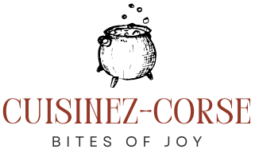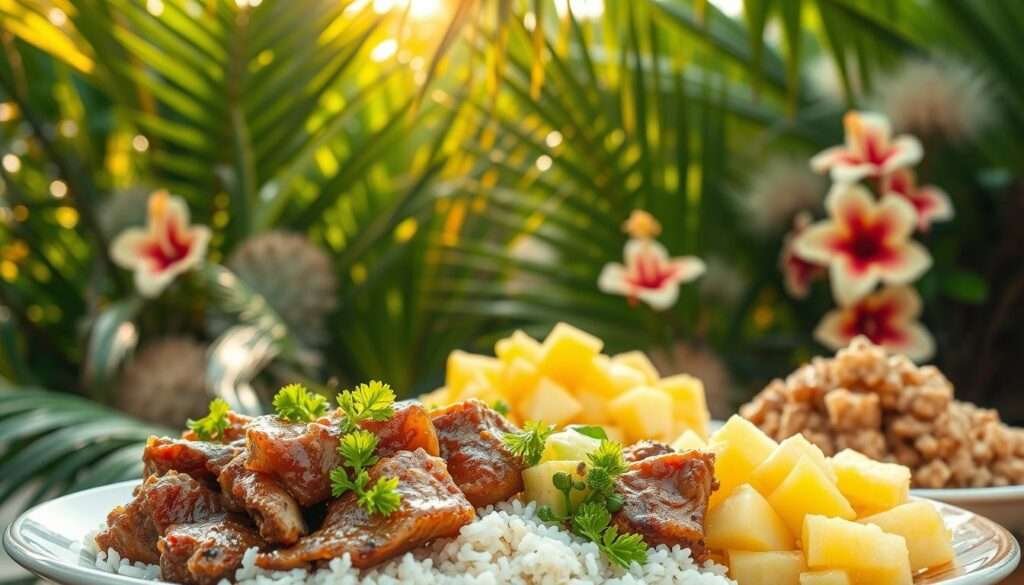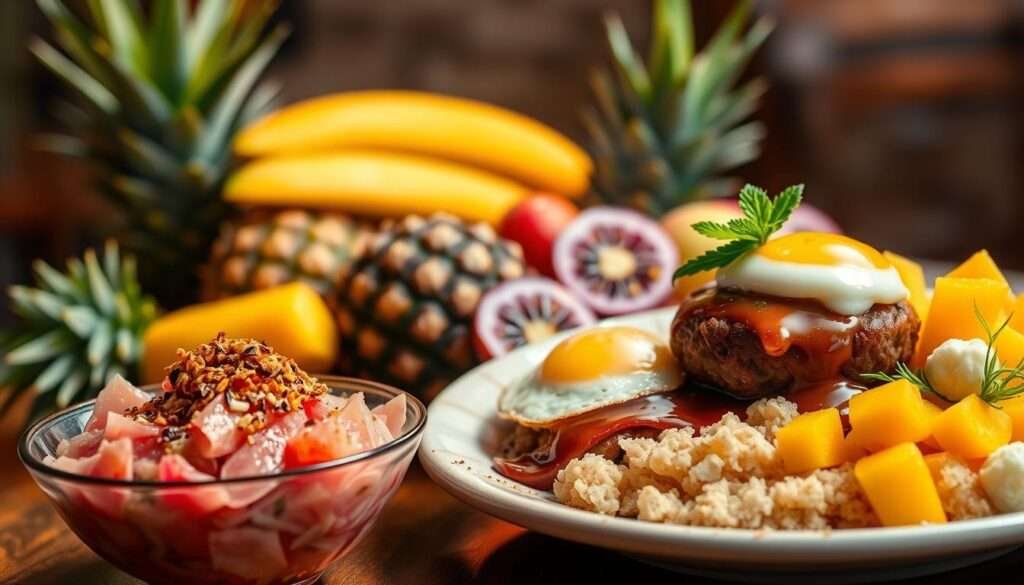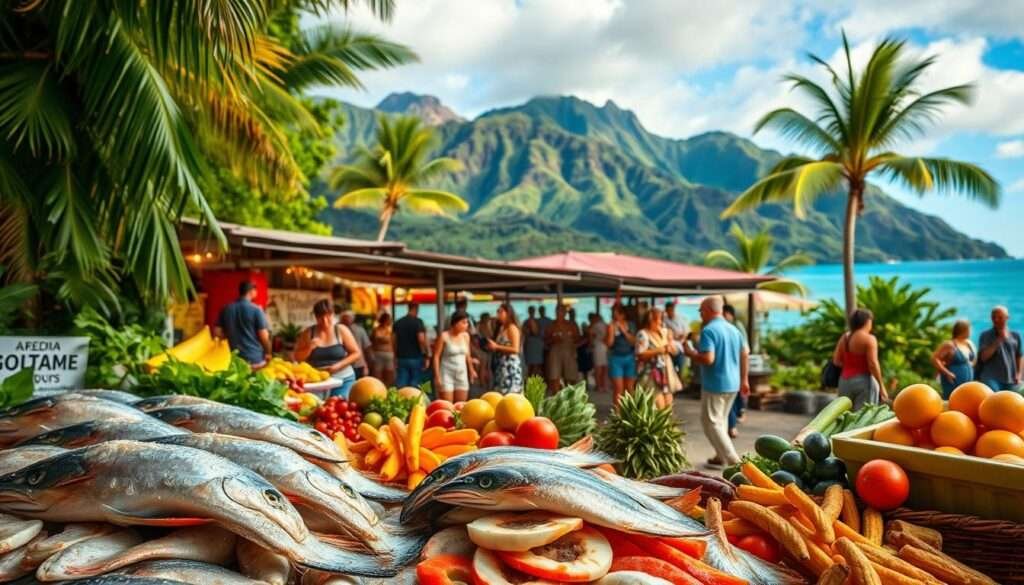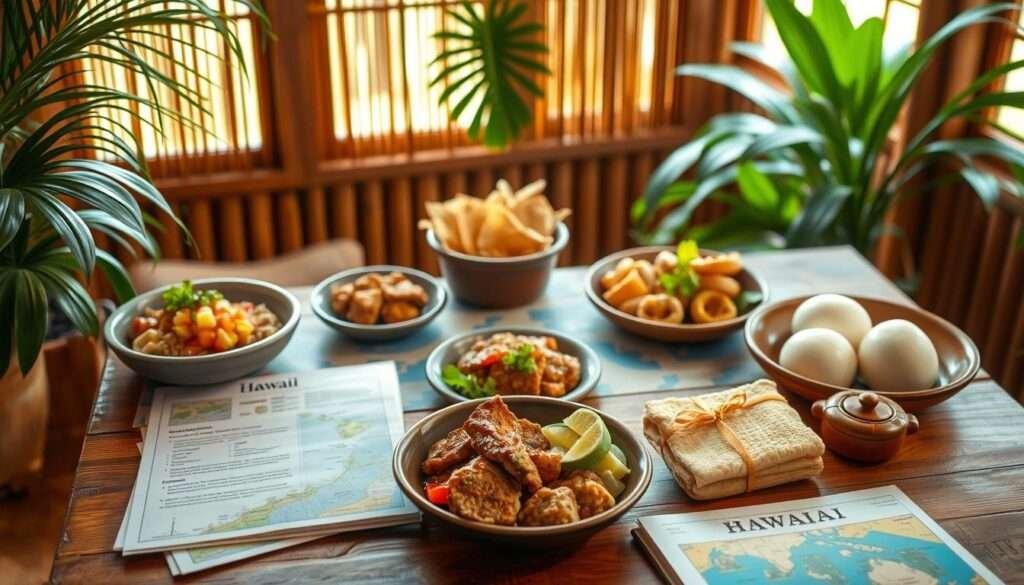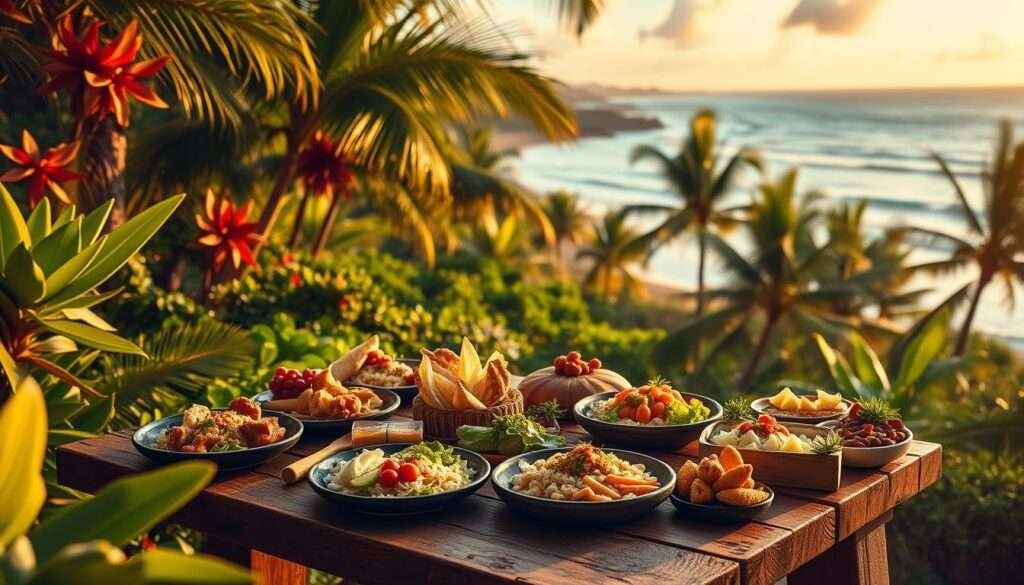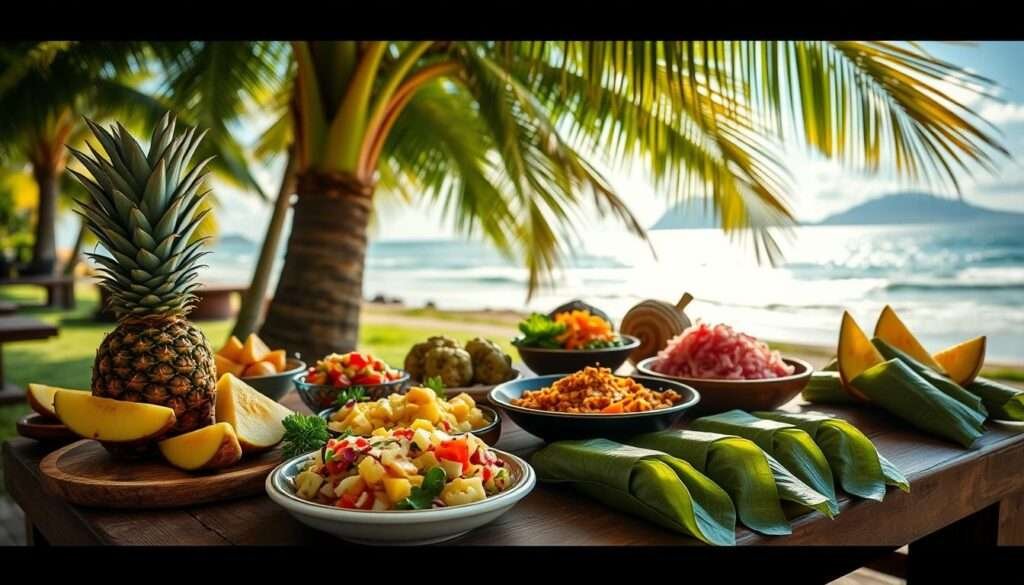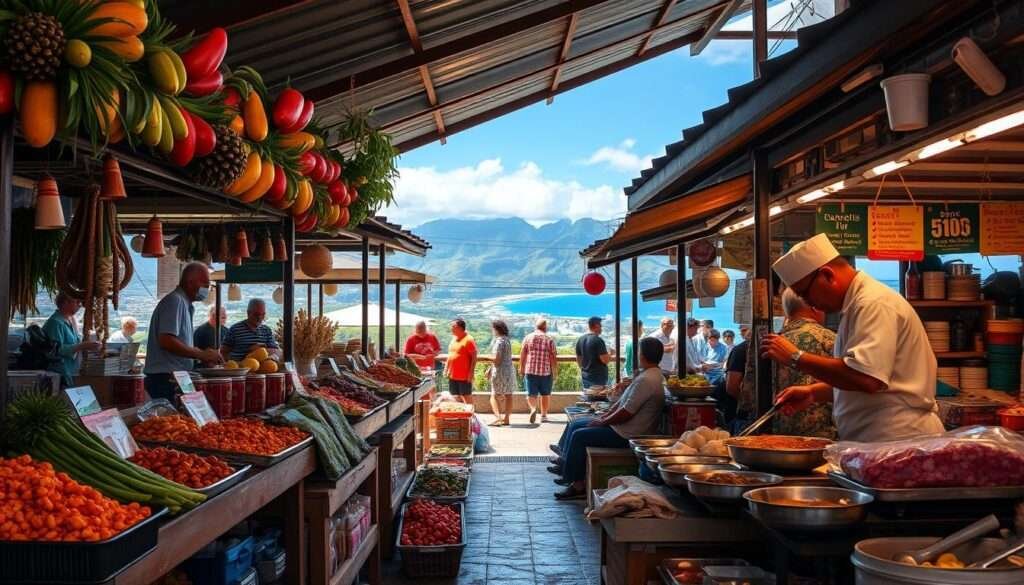Hawaii’s culinary scene is a vibrant tapestry of flavors, weaving together Polynesian, Asian, and Western influences. Every bite tells a story of tradition, innovation, and cultural harmony. From family-run bakeries to roadside garlic shrimp trucks, the islands offer a feast for the senses.
Exploring the food here feels like uncovering hidden treasures. Traditional Hawaiian dishes, local comfort food, and the refined artistry of Hawaiian Regional Cuisine each bring something unique to the table. These flavors are more than just meals—they’re a celebration of life and community.
I’ve always been captivated by how food connects people. In Hawaii, it’s a way of sharing history, love, and aloha spirit. Whether you’re savoring iconic dishes or discovering lesser-known gems, every meal feels like an adventure. Let’s dive into this delicious journey together.
Introduction to Hawaiian Cuisine
The flavors of Hawaiian cuisine are a beautiful blend of history and culture. Over time, the islands’ food has evolved, influenced by Polynesian, Asian, and Western traditions. This unique mix has created a culinary identity that’s both comforting and exciting.
A Melting Pot of Flavors
Hawaiian food is a reflection of its diverse heritage. Traditional staples like poi and kalua pork have been enjoyed for centuries. These dishes were made with simple ingredients but carried deep cultural meaning.
In the 19th century, immigrant workers brought their own flavors. Chinese char siu bao became manapua, and Japanese musubi transformed into Spam musubi. These hybrid dishes are now staples of local comfort food.
The Evolution of Hawaiian Food
Hawaiian cuisine has seen many changes over time. Plantation-era workers created dishes like saimin, a Chinese-Japanese noodle soup. These meals were hearty and practical, perfect for long workdays.
In the 1990s, chefs like Alan Wong led the Hawaiian Regional Cuisine movement. They focused on using island-grown ingredients to create fine dining experiences. This marked a new chapter in the islands’ culinary story.
| Traditional Dishes | Modern Influences |
|---|---|
| Poi (taro paste) | Hawaiian poke bowls |
| Kalua pork | Spam musubi |
| Lomi salmon | Butter mochi |
Today, Hawaiian food is a mix of old and new. From traditional luau feasts to everyday plate lunches, it’s a cuisine that continues to evolve. Every dish tells a story of the islands’ rich history and vibrant culture.
Traditional Hawaiian Dishes You Can’t Miss
The heart of Hawaiian food lies in its time-honored recipes. These dishes are more than just meals—they’re a connection to the islands’ history and culture. From earthy poi to smoky kalua pork, each bite tells a story.
Poi: The Staple of Hawaiian Cuisine
Poi is a traditional dish made from taro root. Its smooth, slightly tangy flavor is an acquired taste for some. Many people think it’s bland, but it’s actually a versatile base that pairs well with richer dishes.
At the Waiahole Poi Factory, you can try poi alongside lau lau—kalua pork wrapped in taro leaves. It’s a combo plate that showcases the best of Hawaiian flavors. My first taste of poi at a luau buffet was a memorable experience.
Kalua Pork: A Luau Favorite
Kalua pork is a must-try dish, especially at a traditional luau. It’s cooked in an imu, an underground oven, which gives it a smoky, tender texture. The slow cooking process infuses the meat with incredible flavor.
Helena’s Hawaiian Food is famous for its award-winning kalua pork. Served with cabbage and rice, it’s a dish that embodies the spirit of Hawaiian comfort food.
Lomi Salmon: A Refreshing Side Dish
Lomi salmon is a bright, refreshing side dish made with salted salmon, tomatoes, and onions. Its tangy flavor contrasts beautifully with richer dishes like poi or kalua pork.
This dish has its roots in the islands’ history, where salted fish was a staple. Today, it’s a beloved addition to any Hawaiian plate, adding a burst of freshness to every bite.
Modern Hawaiian Favorites
Modern Hawaiian cuisine is a delightful fusion of tradition and innovation. The islands’ food scene continues to evolve, blending classic recipes with contemporary twists. From fresh seafood to sweet treats, these dishes capture the essence of Hawaii’s vibrant culture.
Poke: Hawaii’s Raw Fish Delight
Poke is a staple of modern Hawaiian cuisine. This raw fish dish is both simple and flavorful. Traditional versions use limu seaweed, while modern takes often feature spicy mayo or sesame sauce.
For the freshest poke, visit Tamashiro Market in Honolulu or Da Poke Shack on the Big Island. Their ahi poke is a must-try, offering a perfect balance of texture and flavor.
Spam Musubi: The Ultimate Portable Snack
Spam musubi is a beloved Hawaiian snack with a unique history. Introduced during WWII, Spam became a local favorite. Today, it’s a staple in lunchboxes and convenience stores.
While 7-Eleven offers quick options, Lawai Menehune Food Mart serves homemade versions that are worth the trip. My first attempt at making musubi ended in disaster, but it’s a fun dish to try at home.
Shave Ice: A Sweet Treat for Hot Days
Shave ice is the perfect way to cool off on a sunny Hawaiian day. This dessert is an art form, with finely shaved ice and flavorful syrups. Toppings like mochi and li hing mui add extra depth.
Ululani’s is known for its meticulous technique, while Matsumoto’s gained fame after a visit from President Obama. Both spots offer a refreshing taste of Hawaii’s sweet side.
Where to Eat the Best Hawaiian Foods
Exploring the best places to enjoy Hawaiian cuisine is an adventure in itself. From iconic restaurants to hidden gems, the islands offer a variety of spots that cater to every taste. Whether you’re craving traditional dishes or modern twists, there’s a perfect spot waiting for you.
Top Restaurants for Traditional Hawaiian Dishes
For a taste of classic Hawaiian flavors, Rainbow Drive-In is a must-visit. Their Mix Plate, featuring BBQ beef, mahimahi, and chicken, is a crowd favorite. Another great option is Zippy’s, known for its comforting saimin and other local staples.
Helena’s Hawaiian Food is another gem, serving award-winning kalua pork and other traditional dishes. These spots offer a delicious way to experience the islands’ culinary heritage.
Best Spots for Modern Hawaiian Cuisine
If you’re looking for contemporary takes on Hawaiian food, the North Shore shrimp trucks are a great choice. Giovanni’s and Fumi’s Kahuku are two popular options, each offering their own unique spin on garlic shrimp.
For a sweet treat, Leonard’s Bakery is famous for its malasadas. Arrive early to avoid the crowds and enjoy these Portuguese-inspired doughnuts with a Hawaiian twist.
Hidden Gems for Authentic Local Eats
For a truly local experience, visit Aunty Sandy’s on the Road to Hana. Her banana bread is legendary and worth the drive. Another hidden gem is L&L Drive-Inn, a plate lunch institution that rivals Rainbow Drive-In.
When visiting busy areas like Haleiwa, plan ahead for parking to make your meal hassle-free. These lesser-known spots offer a genuine taste of Hawaiian culture and hospitality.
Bucket List Foods to Try in Hawaii
From savory seafood to sweet treats, Hawaii offers unforgettable culinary delights. These dishes are more than just meals—they’re experiences that capture the spirit of the islands. Whether you’re a first-time visitor or a seasoned traveler, these bucket list foods are a must.
Garlic Shrimp from the North Shore
One bite of garlic shrimp from the North Shore, and you’ll understand why it’s legendary. Giovanni’s Shrimp Truck is a standout, serving plump shrimp drenched in a rich garlic butter sauce. Paired with a mountain of rice, it’s a meal that leaves you in a happy food coma.
For the best experience, visit during off-peak hours to avoid long lines. The combination of fresh shrimp and bold flavors makes this dish a must-try.
Malasadas: Portuguese Doughnuts with a Hawaiian Twist
Malasadas are a sweet treat that’s hard to resist. These fluffy Portuguese doughnuts have become a Hawaiian favorite. Leonard’s Bakery is famous for its classic version, while Punalu’u Bake Shop offers a unique guava-filled option.
Tex Drive-In’s square malasadas are another fun twist. Each bite is a mix of soft dough and sweet filling, making them the perfect dessert or snack.
Loco Moco: A Hearty Hawaiian Breakfast
Loco moco is the ultimate comfort food. This hearty dish features a bed of rice topped with a hamburger patty, fried egg, and gravy. Cafe 100 in Hilo takes it to the next level with over 30 variations, including Spam and Portuguese sausage options.
My attempt to finish their “Super Moco” was both hilarious and humbling. Pair it with a cup of Kona coffee at sunrise for the ultimate Hawaiian breakfast experience.
Engaging Information About Hawaiian Food Culture
Food in Hawaii is more than sustenance—it’s a way of life. Every meal reflects the islands’ history, culture, and sense of community. From humble beginnings to modern innovations, the culinary scene here is a testament to the spirit of aloha.
The History Behind Hawaiian Plate Lunches
Plate lunches are a cornerstone of Hawaiian comfort food. Originating in the 1880s, they were inspired by plantation workers’ bento boxes. These hearty meals typically include “two scoop rice,” a protein, and macaroni salad.
The phrase “two scoop rice” is a nod to the dish’s filling nature. It’s a simple yet satisfying meal that has stood the test of time. Today, plate lunches are a beloved staple, enjoyed by locals and visitors alike.
How Hawaiian Regional Cuisine is Changing the Game
Hawaiian Regional Cuisine (HRC) has redefined the islands’ food scene. Spearheaded by chefs like Roy Yamaguchi, HRC focuses on farm-to-table practices. MW Restaurant in Honolulu is a prime example, showcasing locally sourced ingredients in innovative dishes.
This movement has elevated Hawaiian food to new heights. It blends tradition with modern techniques, creating a unique dining experience. The emphasis on fresh, local produce ensures every bite is bursting with flavor.
The Role of Food in Hawaiian Celebrations
Food plays a central role in Hawaiian celebrations. From baby luaus to first birthdays, every event is marked by a feast. Kalua pig, poi, and lomi salmon are often featured, symbolizing abundance and togetherness.
At a Paradise Cove luau buffet, I experienced the true meaning of ohana (family). The shared meal brought people together, creating memories that lasted long after the plates were cleared. Food in Hawaii is more than nourishment—it’s a celebration of life and community.
Easy Tables for Planning Your Food Adventure
Planning your Hawaiian food adventure is easier with these handy tables. Whether you’re looking for the best eats, hotels with great dining options, or fun food-related activities, this guide has you covered. Save time and make the most of your trip with these practical tips.
Top Places to Eat in Hawaii
Hawaii is home to some incredible restaurants and eateries. From poke bowls to traditional plates, here are a few spots you won’t want to miss. Arrive early to avoid long lines and secure parking, especially in busy areas.
| Location | Specialty | Tip |
|---|---|---|
| Da Poke Shack | Ahi Poke Bowls | Go before 11AM |
| Ted’s Bakery | Haupia Pie | Cash only |
| Highway Inn | Lau Lau Plate | Free poi samples |
Best Hotels with Great Food Options
Some hotels in Hawaii offer more than just a place to stay—they’re culinary destinations. Look for accommodations with on-site restaurants or partnerships with local chefs. This way, you can enjoy delicious meals without leaving your hotel.
Must-Do Food-Related Activities in Hawaii
Add these activities to your to-do list for a truly immersive experience. Visit farmers’ markets, take a cooking class, or explore food trucks. These activities offer a deeper connection to the islands’ vibrant food culture.
Reviews of Must-Try Hawaiian Dishes
The flavors of Hawaii are as diverse as its people, each dish telling a unique story. From fresh seafood to smoky meats, the islands’ culinary creations have earned rave reviews from locals, visitors, and experts alike. Here’s what they have to say about some of the most iconic dishes.
What Locals Say About Poke
For locals, poke is more than just a dish—it’s a way of life. Uncle Clayton, a fisherman at Hilo Farmers Market, puts it simply: “Real poke ain’t got avocado!” He emphasizes the importance of fresh ingredients and traditional preparation.
Visitors often compare prepackaged poke from Foodland to the fresh versions found at local markets. The difference in texture and flavor is undeniable. Fresh poke is a must-try for anyone seeking an authentic Hawaiian experience.
Visitor Reviews of Kalua Pork
Kalua pork has won over countless visitors with its smoky, tender flavor. One tourist described it as “better than BBQ,” praising its simplicity and depth of taste. Yelp reviews often highlight Helena’s Hawaiian Food as a top spot for this dish.
However, some visitors note that resort luau versions can’t compare to the pork served at roadside stands. The highway versions are often smokier and more flavorful, making them a favorite among adventurous eaters.
Expert Opinions on Shave Ice
Shave ice is a beloved treat, but not all versions are created equal. Honolulu Magazine ranks Ululani’s and Matsumoto’s as top contenders. Ululani’s employees suggest asking for an ice cream bottom to enhance the texture and flavor.
Experts also compare the fine, snow-like texture of Matsumoto’s shave ice to the slightly coarser version at Wailua Shave Ice. Both are delicious, but the choice often comes down to personal preference.
Practical Tips for Enjoying Hawaiian Food
Navigating Hawaiian food spots can be a breeze with a few insider tips. Whether you’re ordering like a local or finding the best times to visit, these suggestions will enhance your culinary adventure. From food trucks to markets, here’s how to make the most of your experience.
How to Order Like a Local
Ordering food in Hawaii is an art. A phrase like “Brah, one mix plate wit’ extra gravy” can go a long way. This pidgin phrase is a nod to the local culture and ensures you get exactly what you want. At spots like Rainbow Drive-In, this approach is especially helpful.
Another tip is to ask for poi samples at places like Waiahole Poi Factory. It’s a great way to try this traditional dish before committing to a full plate. For more insights, check out this guide to Hawaiian foods.
Best Times to Visit Popular Food Spots
Timing is everything when it comes to avoiding crowds. Rainbow Drive-In has a lull between 2-4PM, making it the perfect time to grab a mix plate. For North Shore shrimp trucks like Giovanni’s, early mornings or late afternoons are ideal to skip the rush.
Kalihi Market is another spot where timing matters. Arriving early ensures you get the freshest poke and other local favorites. Planning your visits during these best times can save you from long waits.
Tips for Navigating Food Trucks and Markets
Food trucks are a staple of Hawaiian cuisine, but parking can be tricky. At Giovanni’s, arrive early to secure a spot. Many trucks prefer cash, so keep some on hand for quick transactions.
Markets like Kalihi Market have their own rules. Bring reusable utensils for beach picnics to enjoy your food sustainably. These small hacks make exploring food trucks and markets a seamless experience.
| Spot | Best Time | Tip |
|---|---|---|
| Rainbow Drive-In | 2-4PM | Order a mix plate with extra gravy |
| Giovanni’s Shrimp Truck | Early morning or late afternoon | Bring cash and arrive early for parking |
| Kalihi Market | Early morning | Bring reusable utensils |
Exploring Hawaiian Food Beyond the Plate
Hawaiian cuisine extends far beyond the plate, offering a deeper connection to culture and community. It’s a celebration of fresh ingredients, family traditions, and global influences. Whether you’re cooking at home or savoring a dish abroad, the flavors of Hawaii tell a story of innovation and heritage.
The Role of Fresh Ingredients in Hawaiian Cuisine
Freshness is at the heart of Hawaiian cooking. Places like Ma’o Organic Farms and Kualoa Ranch emphasize farm-to-table practices, ensuring every dish is bursting with flavor. Chef Mark Noguchi’s luau stew, for example, highlights the importance of locally sourced ingredients.
Using fresh produce not only enhances taste but also supports local farmers. It’s a sustainable approach that connects diners to the land and its bounty. This commitment to quality is what makes Hawaiian cuisine truly special.
How to Make Hawaiian Dishes at Home
Bringing the flavors of Hawaii into your kitchen is easier than you think. Start with a simple poke recipe using supermarket ahi, soy sauce, and sesame oil. Pair it with rice and a sprinkle of green onions for a quick, delicious meal.
For something heartier, try Chef Noguchi’s luau stew. It’s a comforting dish made with taro leaves, coconut milk, and your choice of protein. Hawaiian cookbooks by local chefs are also great resources for authentic recipes.
The Influence of Hawaiian Food on Global Cuisine
Hawaiian food has made waves beyond the islands. Poke, for instance, has become a global sensation, with chains like Sweetgreen offering their own versions. Even Chipotle tried to introduce poke bowls, though they didn’t quite capture the essence of the original.
Poi has also gained popularity in health food circles for its nutritional benefits. Its resurgence shows how traditional Hawaiian ingredients can adapt to modern tastes. This global influence highlights the versatility and appeal of Hawaiian cuisine.
Must-Try Local Foods in Hawaii & Where to Eat Them
Every bite in Hawaii feels like a journey through its rich history and vibrant culture. From sunset dinners at Duke’s Barefoot Bar to late-night snacks at a roadside stand, the islands’ food scene is a treasure trove of flavors and memories. It’s not just about the dish—it’s about the experience.
Final Thoughts on Hawaiian Culinary Adventures
One of my most cherished memories is a sunset dinner at Duke’s Barefoot Bar. The sound of waves crashing, the warm breeze, and the fresh catch of the day made it unforgettable. But it’s not just the high-end spots that leave a mark. Some of the best meals I’ve had came from hole-in-the-wall joints, where the flavors were just as bold and the stories even richer.
Food memories, I’ve found, often outlast beach photos. They stay with you, reminding you of the people, places, and moments that made your trip special. To truly connect with the islands, I encourage every traveler to take a cooking class. It’s a fun way to bring a piece of Hawaii back home.
Why Hawaiian Food is a Must-Experience for Every Traveler
Hawaiian food is more than just a meal—it’s a celebration of culture, community, and creativity. Whether you’re savoring a traditional dish or trying a modern twist, each bite tells a story. And while resort buffets are convenient, they often miss the heart of what makes the islands’ cuisine so special.
Skip the buffet—your taste buds will thank you. Instead, explore the local spots, talk to the chefs, and let the flavors guide you. Trust me, it’s an adventure worth taking.
| High-End Spots | Hole-in-the-Wall Gems |
|---|---|
| Duke’s Barefoot Bar | Giovanni’s Shrimp Truck |
| MW Restaurant | Rainbow Drive-In |
| Roy’s Waikiki | Helena’s Hawaiian Food |
Your Hawaiian Food Journey Awaits
Your food adventure in the islands is a gateway to discovering unique flavors and traditions. Start by creating a personalized itinerary to ensure you don’t miss any must-try dishes. Apps like Yelp Hawaii and Street Food Finder can help you locate the best spots effortlessly.
Don’t forget to pack stretchy pants—trust me, you’ll need them. For a truly local experience, visit the Aloha Swap Meet and grab a fresh coconut from the vendor near the entrance. It’s a refreshing treat that’s perfect for a sunny day.
As you explore, remember to go at your own pace. Embrace the island way of life and savor every bite. Whether it’s a plate lunch or a sweet shave ice, each dish tells a story. So, go eat like you’re on island time—your taste buds will thank you!
